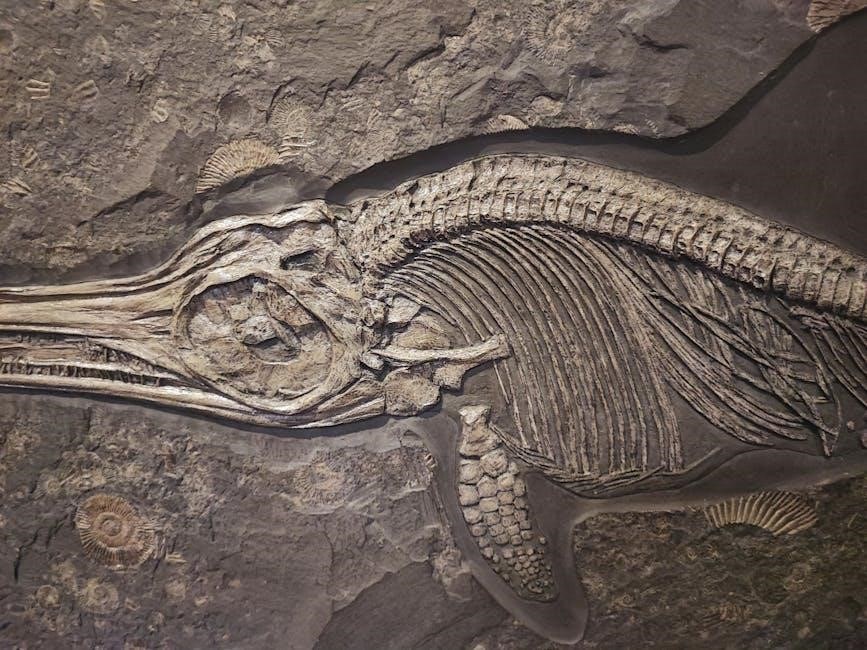Samuel Taylor Coleridge’s The Rime of the Ancient Mariner, first published in 1798, is a haunting narrative poem exploring guilt, redemption, and the supernatural, set aboard a doomed ship.
1.1 Background and Publication
The Rime of the Ancient Mariner was first published in 1798 as part of the collection Lyrical Ballads, a collaborative work with William Wordsworth. The poem was inspired by Coleridge’s fascination with the supernatural and the sea, drawing from a dream by his friend, James Cruikshank. Initially met with mixed reviews due to its unconventional narrative style, it gained recognition over time. The 1834 version, with its added glosses, became the most widely read edition. Today, the poem is celebrated for its exploration of guilt, isolation, and nature, and is available as a free PDF through platforms like the Poetry Foundation, ensuring its accessibility to modern readers.

Major Themes
The poem explores themes of guilt, redemption, and humanity’s relationship with nature, emphasizing the consequences of actions and the enduring power of the natural world.
2.1 Guilt and Redemption
The poem delves deeply into the themes of guilt and redemption, as the mariner’s actions lead to profound consequences. His impulsive killing of the albatross, a symbol of good fortune, sparks a chain of guilt-driven events. The mariner’s journey becomes one of atonement, as he endures isolation and torment, reflecting on his wrongdoing. The poem illustrates how guilt can consume the human spirit, while also offering hope for redemption through self-reflection and acceptance of responsibility. The mariner’s eventual appreciation of nature’s beauty, even in its darkest forms, signifies his path toward forgiveness and inner peace, highlighting the transformative power of redemption.
2.2 Nature and the Environment
The poem vividly explores the relationship between humanity and nature, emphasizing the interconnectedness of all living beings. The mariner’s journey unfolds against the backdrop of the vast, often unforgiving natural world, symbolized by the sea, ice, and wildlife. The albatross represents the beauty and mystery of nature, while its death underscores the consequences of humanity’s disregard for the environment. The poem highlights the delicate balance of nature and the repercussions of disrupting it. Through vivid imagery, Coleridge portrays nature as both awe-inspiring and terrifying, reinforcing the idea that humanity must respect and coexist with the natural world to avoid destruction. This theme remains a powerful commentary on environmental stewardship and the enduring impact of human actions on nature.

Symbolism in the Poem
The poem is rich in symbolism, using elements like the albatross, the ship, and the mariner to convey themes of guilt, isolation, and supernatural intervention.
3.1 The Albatross
The albatross is a central symbol in the poem, representing both a blessing and a curse. Initially, it appears as a sign of good fortune, guiding the ship through treacherous waters. However, when the mariner kills it, the bird transforms into a symbol of guilt and burden. Its presence haunts the mariner, physically and spiritually, as its corpse hangs around his neck. The albatross embodies the consequences of thoughtless actions and the weight of responsibility. It also serves as a catalyst for the mariner’s journey toward redemption, teaching him to appreciate the beauty of creation. The albatross’s dual nature underscores the poem’s exploration of human error and the path to forgiveness.
3.2 The Ship
The ship in The Rime of the Ancient Mariner serves as both a physical vessel and a symbolic representation of the mariner’s journey. It is the setting where the mariner’s actions unfold, isolating him from the rest of humanity. The ship’s fate is deeply tied to the mariner’s guilt, as it becomes a floating prison where he endures supernatural punishments. The ship also symbolizes the fragility of human existence against nature’s power. Its journey from calm seas to icy tundras and eventual stillness mirrors the mariner’s spiritual descent and quest for redemption. The ship’s crew, who initially trust the mariner, later turn against him, highlighting themes of isolation and collective judgment. Ultimately, the ship’s fate serves as a reminder of the consequences of human arrogance and the enduring power of nature.
3.3 The Mariner
The Ancient Mariner is the central character of the poem, whose actions and emotions drive the narrative. His decision to shoot the albatross sparks the unfolding tragedy, leading to guilt, isolation, and a profound transformation. The mariner represents humanity’s capacity for both destruction and redemption. Throughout the poem, he evolves from a careless sailor to a contemplative figure who gains a deeper understanding of nature and spirituality. His journey is marked by supernatural encounters, suffering, and ultimate forgiveness. The mariner’s story serves as a moral lesson, emphasizing the consequences of one’s actions and the interconnectedness of all living beings. His character embodies the universal human struggle with guilt and the quest for reconciliation.

Structure and Narrative Style
The poem is structured as a ballad with a frame narrative, using archaic language and rhythmic patterns to evoke a mystical and doom-laden atmosphere effectively.
4.1 The Frame Narrative
The poem employs a frame narrative structure, where an unnamed narrator recounts the tale of the ancient mariner. This technique creates a sense of immediacy and intimacy, drawing readers into the mariner’s haunting journey.
Coleridge’s use of a frame narrative allows for dual perspectives: the mariner’s guilt-ridden confession and the listener’s evolving reactions. The old sailor’s interruption of the wedding guest symbolizes the inevitability of confronting one’s past, while the guest’s trance-like state underscores the tale’s mesmerizing power.

Themes (continued)
The poem delves into profound themes of isolation and loneliness, emphasizing the mariner’s emotional journey and supernatural encounters, which explore human frailty and existential dilemmas.
5.1 Isolation and Loneliness
In The Rime of the Ancient Mariner, isolation and loneliness are central themes, deeply intertwined with the mariner’s journey. His act of killing the albatross alienates him from the crew, symbolizing humanity’s disconnection from nature. The crew’s eventual death leaves him alone, surrounded by endless water, emphasizing his existential isolation. The poem explores how guilt and supernatural elements exacerbate his loneliness, creating a psychological and emotional chasm. The mariner’s isolation serves as both a punishment and a pathway to redemption, highlighting the profound consequences of human actions and the enduring weight of solitude. This theme resonates universally, reflecting on the human condition and our intrinsic need for connection and forgiveness.
5.2 Supernatural Elements
The poem is rich in supernatural elements that shape its eerie and haunting narrative. The albatross, a symbol of misfortune, embodies a supernatural force that disrupts the natural order. The appearance of ghostly spirits and the spectral ship, crewed by Death and Life-in-Death, furthers the supernatural atmosphere. These elements convey the mariner’s psychological torment and the consequences of his actions. The curse that befalls the crew and the mariner’s ultimate isolation underscore the poem’s exploration of guilt and redemption. Coleridge’s use of the supernatural creates a sense of awe and dread, reinforcing the poem’s themes of human frailty and the mysteries of the universe. These elements remain central to the poem’s enduring fascination and interpretation.
The Poem’s Reception

The poem initially faced mixed reviews but gradually gained recognition for its gothic themes and moral complexity, becoming a cornerstone of Romantic literature and enduring as a timeless classic.

6.1 Initial Reception and Criticism
Upon its publication in 1798, The Rime of the Ancient Mariner received mixed reviews. Critics found its supernatural elements and moral ambiguity unsettling, with some dismissing it as bizarre or overly simplistic; The poem’s experimental style and lack of a clear moral confused readers accustomed to more conventional poetry. Despite this, its vivid imagery and emotional depth gradually earned recognition. Over time, scholars began to appreciate its exploration of guilt, isolation, and the human condition, transforming it into a celebrated work of Romantic literature.
6.2 Modern Interpretations
Modern interpretations of The Rime of the Ancient Mariner highlight its timeless themes and universal appeal. Scholars often focus on its exploration of guilt, redemption, and humanity’s relationship with nature. Feminist critics analyze the absence of female voices, while environmentalists emphasize the poem’s ecological warnings. Psychological interpretations delve into the mariner’s isolation and the symbolism of the albatross as a burden of conscience. The poem’s ambiguous morality and open-endedness encourage diverse readings, making it a rich text for contemporary analysis. Its enduring relevance underscores Coleridge’s mastery of evoking complex emotions and ideas, ensuring its continued study and appreciation in modern academia and popular culture.

Legacy and Influence
The poem’s haunting imagery and moral complexity have left a profound impact on literature, art, and culture. Its themes of guilt and nature continue to inspire writers, musicians, and filmmakers, cementing its status as a timeless classic.

7.1 Cultural Impact
“The Rime of the Ancient Mariner” has deeply influenced cultural consciousness, becoming a symbol of guilt, isolation, and humanity’s relationship with nature. Its vivid imagery, particularly the albatross, has transcended literature, inspiring countless adaptations in art, music, and film. The poem’s themes resonate universally, making it a cornerstone of Romanticism and a timeless exploration of human morality. Its influence is evident in literature, with writers drawing parallels to its haunting narratives, and in popular culture, where references to the albatross metaphor are common. The poem’s enduring relevance continues to captivate audiences, ensuring its place in cultural heritage and educational curricula worldwide.
7.2 Adaptations and Performances
“The Rime of the Ancient Mariner” has inspired numerous adaptations across various art forms, showcasing its timeless appeal. The poem has been translated into films, stage plays, and even musical compositions. Notable adaptations include a 1975 film featuring David Hemmings and a BBC Radio 4 dramatization. Musically, Iron Maiden’s “The Rime of the Ancient Mariner” captures the poem’s haunting essence. Theatrical performances often emphasize the mariner’s isolation, using innovative staging to reflect the eerie atmosphere. These adaptations highlight the poem’s versatility, ensuring its story continues to resonate with diverse audiences. Its enduring popularity underscores its ability to transcend traditional literary boundaries, making it a favorite for creative reinterpretation.
Accessing the Poem

The poem is widely available in PDF format online, with free downloads from educational websites, libraries, and e-book platforms like Project Gutenberg and Google Books.
8.1 PDF Versions and Online Availability
The Rime of the Ancient Mariner is readily accessible in PDF format, with numerous free and downloadable versions available online. Platforms like Project Gutenberg, Google Books, and ManyBooks offer high-quality, searchable PDFs of the poem, often accompanied by annotations and historical context. Additionally, many educational websites and libraries provide free access to the poem, making it easy for students and enthusiasts to explore Coleridge’s work. Some versions include illustrations or critical commentary, enhancing the reader’s understanding. The poem is also available as part of larger collections of Coleridge’s works, offering a comprehensive reading experience; Audiobook versions in PDF formats are also available on platforms like Librivox, catering to diverse preferences.
The Rime of the Ancient Mariner remains a profound exploration of guilt, isolation, and nature. Its themes continue to resonate, making it a timeless piece.
9.1 Final Thoughts
9.2 Continuing Relevance
The Rime of the Ancient Mariner remains a deeply relevant work in modern times, offering timeless reflections on guilt, isolation, and humanity’s relationship with nature. Its exploration of universal themes, such as environmental degradation and the consequences of unchecked ambition, resonates strongly in today’s ecological consciousness. The poem’s availability in PDF and online formats ensures its accessibility to new generations of readers. Its haunting imagery and moral complexities continue to inspire literary analysis, artistic adaptations, and philosophical debates. Coleridge’s masterpiece serves as a reminder of the enduring power of poetry to explore the human condition, making it a work that continues to captivate and provoke thought in the 21st century.



